Remember, Water harvesting Principles:
Make the running water to walk, walking water to crawl, crawling water to stay and sink
“Catch the water in the hills during 4 months of monsoon, Store the water in rivers and river lets during next 4 months, Summer 4 months will have enough water”
-Shree Padre
This applies to both coastal as well as mainland regions.
Plan of action
“Catch the water in the hills during 4 months of monsoon”
1. Dig catch pits using excavators in hilly terrains
2. Build small check dams along all road side water drains and boundry markings (Agalu)
3. Catch pits in the corners of play grounds, drying yards and near the wells
4. Divert the rain water to natural as well as man made pits (like laetrite quarry). Plant live fence, if needed.
5. Bore well feeding Could be directly fed from nearby fresh water spring/ roof water. Or digging a pit nearby and diverting rain water. No costly Govt. design is needed.
Water percolation in boundary trenches and road drains
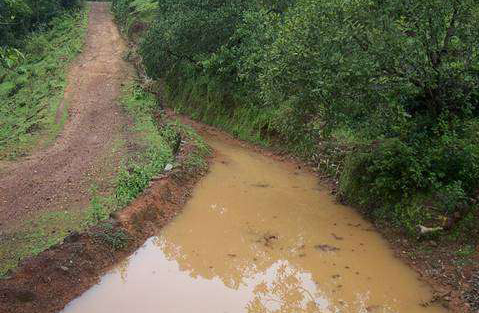
Blocks are built at regular intervals in the demarcation - cum - cattle barrier trench and also road drains. An easy way to collect water for percolation
Recharging the borewell
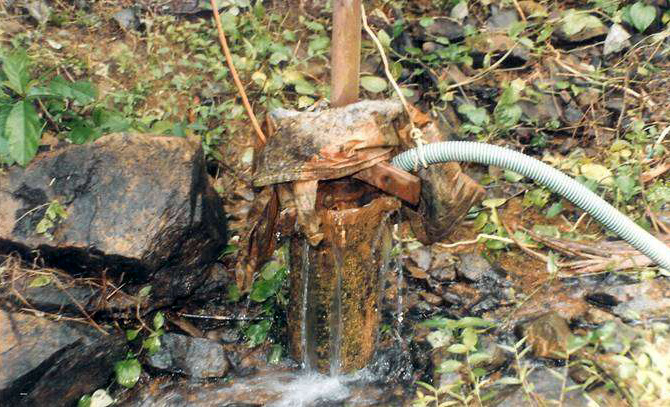
Two borewells of Varanashi farms get directly fed with clean water from the nearby irrigation tanks during rainy season. Such arrangement is also made for an openwell used for drinking purposes
Store water in rivers and rivulets during next 4 months; the summer months will have enough water
Build as many katta’s (temperory mini dams following VRF sand/sand bag and plastic technology or any suitable traditional technique across rivulets and rivers. Water could be stored in large rivers like Netravati and Kumaradhara.

VRF sand and plastic dam (2012) across the Seere river
Varanashi sand bag and plastic barrage - Improvement over the traditional katta
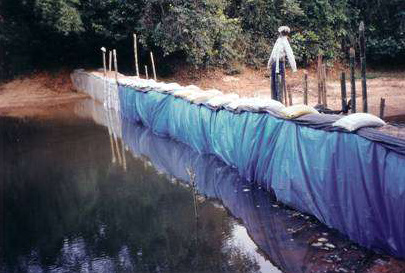
Varanashi sand bag and plastic barrage first attempt
In the beginning of the 2003 summer, a temporary barrage (35 m length and 3 m height) had been constructed across the Seere river. Due to this structure, water accumulated in 1.5 kilometers of the river
The dam was constructed using sand bags and tank lining plastic sheets in place of stones and mud respectively. The new method avoids the use of soil (the traditional method) which is washed down while opening the barrage with the onset of rainy season. The barrage helped tide over the water scarcity in the summer of 2003, also improving the water availability along the banks of the river.
The success of this method has prompted farmers around to adopt it. Ten such barrages had been constructed during summer 2005.
Construct water reserves using plastic lining laterite mines
Natural pits could be lined with little effort. Fill them with good water from nearby source when flow is still on. Laterite mines(Kalpane) an excellent water harvesting structure during rainy days. Spend some money lining it with thick tank lining plastic sheet. This will make it an excellent low cost storage during summer. We do not need costly RCC tanks in villages. You just need to change the mind set.
Store the water
- Repair and use all the public water tanks to store the water (eg: one in Adyanadka)
- Encourage roof water harvesting. Water from odd summer rains could be properly collected and utilised
- Recycle all waste water
- Plan the irrigation and use

During rainy season, rainwater from the roof of Varanashi industrial shed is collected in a tank and used
How waste water is being used - Gobar gas unit
Near the cattle shed, there is a gobar gas unit receiving the cow dung, the cowshed washings also flow into the unit. The spent slurry is collected in a 5000 litre tank. The household washing is also diverted into the tank
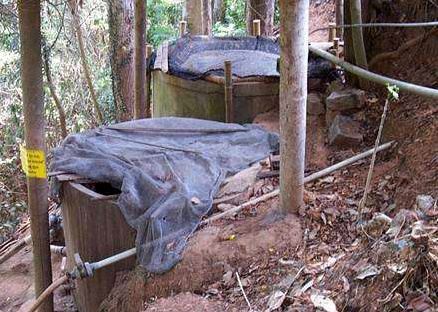
Gobar gas unit receiving the cow dung
After dilution, the slurry is pumped and allowed to flow through pipes for irrigating crops. Similarly, washing from the industrial unit is also used for irrigation without any wastage.
Use of septic tank water
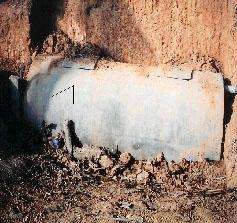
Use of toilet waste needs to be standardized
Standardize the use of toilet waste. From toilet the fecal matter flows into a two chambered septic tank. After digestion, the wastewater flows into a third tank. The treated water with dissolved nutrients flow into plant basin through a distribution pipeline. Thus, nutrient-rich water is properly utilised. There are three such units working now.
(The author can be contacted at Varanashi Research Foundation, Adyanadka 574 260, DK, Karnataka; Tel: +91 8255 270254; info@varanashi.com; www.varanashi.com)





 make_the_best_out_of_the_monsoons.pdf
make_the_best_out_of_the_monsoons.pdf







